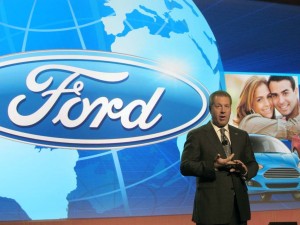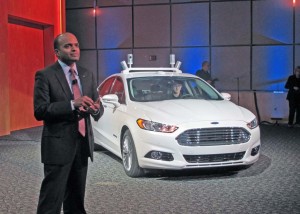
Ford President Joe Hinrichs said the automaker will introduce 23 new models and add 5,000 employees in the coming year.
While it’s likely to be one of the most high-profile models to come, the redesigned Ford Mustang will be just one of 23 new models the automaker plans to add next year, revealed Joe Hinrichs, Ford’s President of the Americas.
The maker plans to also add 5,000 new jobs to support that expansion in the U.S. – while opening three new assembly plants in other parts of the world, Hinrichs said during a media briefing. Along with the new products, 16 of which are targeted to the core North American market, Ford also plans to introduce two new versions of its high-mileage EcoBoost engine family.
The rollout will see “more products launches than in any other year in our history,” Hinrichs proclaimed.
While the executive wouldn’t specifically discuss what all the various new products are, Ford has already either revealed or hinted at some products to come during the 2014 calendar-year, including not just Mustang, but the new Ford Edge and Lincoln MKC crossovers, the Transit and TransitConnect vans and the SuperDuty version of its big F-Series pickup. Industry analysts also believe Ford may reveal the all-new version of its light-duty F-Series truck before the end of 2014.
Ford is hoping to build product momentum in the coming year, especially as it challenges key rivals like General Motors and Toyota, who have significant product plans of their own. Ford has so far gained a half-point of market share in 2013, rising to 15.7%, but Toyota has been outselling it in terms of retail volume.
The maker has been trying to balance its desire to build sales and volume with its equally strong push to build margins and overall profitability. That has led it to take a week of downtime at its Fusion sedan plant this month – despite the big surge in demand for the midsize model this year. And it is reducing by 2% its earlier production plans for the first quarter of 2014.
Nonetheless, Ford is upbeat about the coming year and after adding 14,000 new U.S. jobs over the last two years plans to bring on another 5,000 workers in 2014. But the majority – a total of 3,300 – will fill salaried positions, many in research and development. Of that number, 400 will be dedicated to powertrain development, 100 focusing on battery-based technology. With the U.S. and other key markets rapidly tightening emissions and mileage standards, this could be a critical area for determining which companies will lead the industry.
(Click Here for more on Mustang v. The World.)
Hinrichs noted that Ford plans to add two more engines to its expanding, turbocharged EcoBoost family. That includes a new high-performance 2.3-liter inline-four making over 305 horsepower that will be first offered in the 2015 Mustang. He declined to say what the second EcoBoost engine will be though Hinrichs hinted it should be revealed in the near-term.
The 2.3-liter engine is expected to play a significant role in helping Ford expand distribution of the Mustang, normally focused on the U.S. market, to new outlets worldwide since it will deliver near-V-8 performance with I-4 mileage.
Ford has been pushing to expand its position abroad, and two of the three new assembly plants will be based in China. The maker was relatively late to enter that booming market, especially compared to GM and German rival Volkswagen AG. But Ford’s heavy push in China has so far yielded a 50% bump in sales there this year.
(Is Ford’s Mulally going to Microsoft or not? For more, Click Here.)
During the Thursday news briefing, Ford officials gave insights into not just products but some of the technologies they have under development. Global product development chief Raj Nair revealed a prototype autonomous vehicle that features a number of the systems and technologies that could wind up on Ford vehicles in the next few years, he suggested.
“The Ford Fusion Hybrid automated vehicle represents a vital step towards our vision for the future of mobility,” suggested Nair, noting that with the number of vehicles on world roads expected to jump from the current 1 billion to as much as 4 billion by 2050, autonomous technology could be critical in preventing “global gridlock,” while also reducing the amount of energy that fleet would require.
Ford will update its auto-parking technology in 2014, noted Nair, to handle perpendicular, as well as parallel parking situations.
Stop/start is another one of the technologies Ford officials said they plan to make more widely available. Such a system can automatically shut off a vehicle’s engine rather than wasting gas while idling, say, at a stoplight. The engine restarts the moment the driver’s foot lifts off the gas pedal. Stop/Start can yield as much as a 5 to 7% improvement in fuel economy, according to industry engineers.
Ford says it plans to offer the technology on a million vehicles sold in the U.S. by 2017, expanding from just the Fusion model today to where it will “ultimately cover 70% of our North American nameplates,” said Hinrichs.


16 new models in the U.S. in one year is a whole lot of effort and investment. At least they are creating a good 5,000 new U.S. jobs.